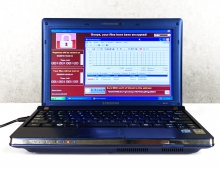
Short-lived Stealthy Attacks Are The New Web Threats
AVG Technologies, a developer of Internet security software, has released statistics that paint a scary picture of the way web-borne threats are developing.
Unlike viruses, which make a point of being obvious and staying around for as long as they can, the primary characteristics of web infections today are stealth and transience ? meaning they are secretive, short-lived, and fast-moving, according to the security firm.
Today?s online threats frequently appear briefly on an otherwise legitimate site, moving on to other sites before they can be identified and blocked. In other instances, the criminal element behind these threats simply sets up hundreds of seemingly-legitimate web sites with embedded infections, promotes them for a day or two, and then shuts them down, never to be seen again. The rate of appearance of these 'here today, gone tomorrow sites' is increasing - in just the past three months, AVG researchers have seen the average number of unique new infective sites appearing growing from 100,000-200,000 a day to 200,000-300,000 a day, a pattern that looks set to continue.
One example of a transient threat is malicious advertising ? known as 'malverts'. Online criminals simply create and submit a ?malvert? to an advertising network, which then unwittingly distributes the malicious advert to hundreds of sites. Computer users clicking on these ads, or even simply exposed to them accidentally, can become infected with data-stealing spyware.
There are plenty of other examples of threats where the user can be infected by simply visiting a web site, without even clicking on a link - so-called 'drive-by downloads' can steal passwords, bank account information, and other valuable personal data without the user being any the wiser. AVG?s research indicates that close to 60% of sites launching ?drive-by downloads? are infective for one day or less. Figure A below shows the typical length of time these transient infections are ?live?.
This transience means that anyone relying on security software that provides protection using traditional virus 'signatures' or by periodically scanning the millions of sites active on the web at any given time is completely unprotected just when they need that protection most: that crucial time when they click a link to a site poisoned with one of these transient infections.
According to AVG Technologies? CEO J R Smith, "the hallmark of today?s web-borne infections is 'here today, gone tomorrow'. Any web security product that relies on visiting and scanning websites to deliver a safety rating to its users would have to visit every one of the hundreds of millions of sites on the Internet every day to provide protection against these threats ? a technological impossibility even with today?s supercomputers."
Transient, rapidly-changing information is also a hallmark of social networks like Facebook and MySpace, so it?s not surprising that cybercriminals have found fertile territory there. Messages from "friends" that direct users to malicious pages, which then download infective malware in the background, are all-too-easy for people to mistakenly trust. Then there are links to music or video clips that ask users to download a seemingly-innocent multimedia program - but which carry a hidden threat.
AVG Technologies? Chief Research Officer Roger Thompson notes three key factors that make it particularly difficult for security companies to track and detect these types of threat:
"Firstly, it takes a long time to detect and close down threats distributed randomly across thousands of different pages on a large social networking site. Secondly, the threat is usually short-lived: a malicious program delivered through a popular site doesn?t need to run for long to attract a large number of victims. And thirdly, the Internet is so large that scanning every web page for a threat that may only be present for a few hours or days is simply not feasible."
AVG claims that it takes a different approach to protecting users against these hidden threats. The company?s LinkScanner web security software brings together data from experts and users alike to provide a crucial layer of real-time protection for all AVG?s security products.
"It?s important that users understand traditional anti-virus software, while still an important part of online security, is no longer able to provide protection against every individual virus out there ? our labs are seeing tens of thousands of new viruses every day. So what we do is look at the behavior of these threats ? which is a much more manageable task because there are far fewer different ways in which the threats are delivered. It?s rather like detecting letter bombs ? we get enough data from our research to be able to identify a threat (the bomb) by the delivery mechanism (the envelope enclosing the bomb)."
Today?s online threats frequently appear briefly on an otherwise legitimate site, moving on to other sites before they can be identified and blocked. In other instances, the criminal element behind these threats simply sets up hundreds of seemingly-legitimate web sites with embedded infections, promotes them for a day or two, and then shuts them down, never to be seen again. The rate of appearance of these 'here today, gone tomorrow sites' is increasing - in just the past three months, AVG researchers have seen the average number of unique new infective sites appearing growing from 100,000-200,000 a day to 200,000-300,000 a day, a pattern that looks set to continue.
One example of a transient threat is malicious advertising ? known as 'malverts'. Online criminals simply create and submit a ?malvert? to an advertising network, which then unwittingly distributes the malicious advert to hundreds of sites. Computer users clicking on these ads, or even simply exposed to them accidentally, can become infected with data-stealing spyware.
There are plenty of other examples of threats where the user can be infected by simply visiting a web site, without even clicking on a link - so-called 'drive-by downloads' can steal passwords, bank account information, and other valuable personal data without the user being any the wiser. AVG?s research indicates that close to 60% of sites launching ?drive-by downloads? are infective for one day or less. Figure A below shows the typical length of time these transient infections are ?live?.
This transience means that anyone relying on security software that provides protection using traditional virus 'signatures' or by periodically scanning the millions of sites active on the web at any given time is completely unprotected just when they need that protection most: that crucial time when they click a link to a site poisoned with one of these transient infections.
According to AVG Technologies? CEO J R Smith, "the hallmark of today?s web-borne infections is 'here today, gone tomorrow'. Any web security product that relies on visiting and scanning websites to deliver a safety rating to its users would have to visit every one of the hundreds of millions of sites on the Internet every day to provide protection against these threats ? a technological impossibility even with today?s supercomputers."
Transient, rapidly-changing information is also a hallmark of social networks like Facebook and MySpace, so it?s not surprising that cybercriminals have found fertile territory there. Messages from "friends" that direct users to malicious pages, which then download infective malware in the background, are all-too-easy for people to mistakenly trust. Then there are links to music or video clips that ask users to download a seemingly-innocent multimedia program - but which carry a hidden threat.
AVG Technologies? Chief Research Officer Roger Thompson notes three key factors that make it particularly difficult for security companies to track and detect these types of threat:
"Firstly, it takes a long time to detect and close down threats distributed randomly across thousands of different pages on a large social networking site. Secondly, the threat is usually short-lived: a malicious program delivered through a popular site doesn?t need to run for long to attract a large number of victims. And thirdly, the Internet is so large that scanning every web page for a threat that may only be present for a few hours or days is simply not feasible."
AVG claims that it takes a different approach to protecting users against these hidden threats. The company?s LinkScanner web security software brings together data from experts and users alike to provide a crucial layer of real-time protection for all AVG?s security products.
"It?s important that users understand traditional anti-virus software, while still an important part of online security, is no longer able to provide protection against every individual virus out there ? our labs are seeing tens of thousands of new viruses every day. So what we do is look at the behavior of these threats ? which is a much more manageable task because there are far fewer different ways in which the threats are delivered. It?s rather like detecting letter bombs ? we get enough data from our research to be able to identify a threat (the bomb) by the delivery mechanism (the envelope enclosing the bomb)."





















